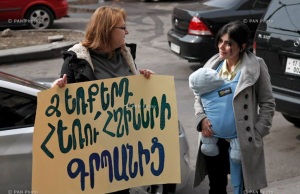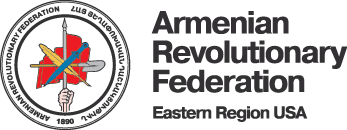Armenian Women Today: Realities and Challenges

Special for the Armenian Weekly
By Mary Matosian & Ani Jilozian
March 8, a day to celebrate the achievements of women all across the world, is here. The United Nations (U.N.) recently declared this year’s theme as “Planet 50-50 by 2030: Step It Up for Gender Equality.” As we celebrate this day and the women and girls in our lives, we must at the same time recognize and be more vocal about the rampant sexism and male domination that sets the foundation for gender inequality and discrimination in our homeland.

‘Just a few years ago, the government tried to abolish paid maternity leave and free vaccinations for infants. Luckily, women’s rights activists were able to retract those decisions through vigorous protesting.’ (Photo: PanArmenian Photo)
Perhaps few know or have difficulty accepting that we face heinous manifestations of gender-based violence, including sex trafficking, rape, and sexual harassment, along with high rates of sex-selective abortion and domestic violence. Armenia has the third highest level of birth masculinity observed globally, with the Gegharkunik region in particular having the highest known rate at 118 males born per 100 females.1 A study carried out by the OSCE found that 60 percent of survey respondents, the vast majority of whom were female, noted that they were subjected to domestic violence during their lifetimes.2
In post-independence Armenia, more women are relegated to secondary roles in society. Women, who make up the majority of the population due to male out-migration, are facing rampant poverty. More and more are single mothers and the sole bread winners for their children and elderly parents. Yet, because women are primarily employed as low-wage service providers, their average monthly wages represent only 64.4 percent of men’s, which gives Armenia one of the largest gender pay gaps in all of Eastern Europe and Central Asia.3 This results in many women living hand-to-mouth, unable to afford decent health care for themselves and their families. Further exacerbating these issues are disappearing safety nets that result in fewer women getting educated and finding work.
The government continues to cast aside any obligation towards its citizens, leaving women in a vulnerable position. Authorities have shown little political will in addressing women’s issues and many national actors are even resistant to improve women’s status in society. It is bizarre and frustrating when government officials, who purport to value the Armenian family, make decisions that directly go against women. Just a few years ago, the government tried to abolish paid maternity leave and free vaccinations for infants. Luckily, women’s rights activists were able to retract those decisions through vigorous protesting.
If we want to see change and have a society that values respect and equality, we need to show that we value women. Yet, we frequently see shows on local television that demean women and portray them as being cheated on, abused, and suicidal. In everyday life, we encounter harmful gender stereotypes. Our study on gender stereotypes and attitudes4 sheds light on the extent to which women are taught to believe that they are incapable of leadership and thought to be less intelligent and capable than men. Children’s textbooks are filled with gender stereotypes in their depiction and illustrations of tasks for females and males. Advertisements reinforce the submissive and subservient role of women. One such advertisement showed a traffic sign with a high heel in the center to alert drivers to the “bad driving” of women.
This March 8 we will once again hear officials making statements, like that of Minister of Education Armen Ashotyan, who exclaimed, “I wish you health, endless love, feminine charm, happiness, smiles, and joy,” or a similar statement by Minister of Defense Seyran Ohanyan, who noted, “I wish you endless charm, fulfillment of dreams, happy smiles, and a nice spring mood.” When asked to elaborate on the image of an Armenian woman, Minister of Diasporan Affairs Hranush Hakobyan flatly stated, “To tell you the truth, I don’t accept filthy, ill-mannered girls. A woman must be modest.” One of the most outspoken clergy members on Armenian television, Hayr Komitas, publicly announced his disapproval of the gender equality law, asserting, “This decision is immoral; it is not only against the will of God but also nature.” What all these authority figures are saying, directly or indirectly, is that women should be relegated to be feminine, beautiful objects and mothers, but not equals to men.
It is no wonder, then, that women are given such a limited role in society. Women representation in the Armenian government is below standard with just three women ministers, no women governors or mayors, and a dismal representation of women in parliament. Women’s issues are not part of political platforms, and women have been absent as decision makers in political parties.
In place of insensitive and harmful statements, we need policies that support women, such as legislation that protects them against domestic violence, an endemic problem in Armenia that one out of four women faces. What assistance is given to those mothers who are unemployed, often as a consequence of abuse, and abandoned by their husbands? One wonders why, with the birth rate cut by 50 percent since the 1980’s, supporting women and families is not made a priority.
Women’s rights activists who drive civil society initiatives are fearlessly standing up for justice. Like the women propelling the early feminist movement forward, these women are working to redress inequalities of all kinds, not only those based on gender. A broad set of issues interest our women, including the fight against corruption, environmental protection, and social justice, as well as the patriarchy that sustains an oligarchic system.
Nothing will change in Armenia if we don’t tackle societal attitudes and gender inequality. No amount of new or renovated schools, clinics, and churches will push social change, especially if women and children who would otherwise benefit from such services cannot access them. A society where women are not active participants can never advance. That is why it is crucial, on this March 8 and going forward, to make our voices heard. We must change harmful gender norms and stereotypes at the interpersonal and community levels, and push the Armenian government to develop and implement legislative policies that positively impact our personal and collective wellbeing. We must make women’s issues a priority in Armenia. It simply cannot wait any longer.
Mary Matosian is the executive director of the Women’s Support Center, Armenia. Her life changed after a trip to Armenia in 1981. She rediscovered her ancestral roots and dedicated herself to extensive work in the Armenian communities of New York and Paris before moving to Armenia in 1990. During the 1990s, she put her methodical research and organizational skills to work as director of “Aznavour pour Armenie,” implementing grants from the European Union’s Humanitarian Commission. She joined the Tufenkian Foundation in 2006 and serves as country director, splitting her time between New York, Armenia and Karabagh. She can be reached at maro@womensupportcenter.org.
Ani Jilozian works as the data analyst/writer at the Women’s Support Center (WSC) in Yerevan, Armenia. She is also an active member of the Coalition to Stop Violence Against Women. Jilozian has worked as a freelance public health consultant and sexual health educator, carrying out research projects in the field of women’s sexual and reproductive health and rights, and leading workshops with women and girls. She received a Fulbright Fellowship for 2012-13, during which time she carried out research and managed an educational program that served hundreds of rural Armenian women.
Notes
1 Guilmoto (2013). Sex Imbalances at Birth in Armenia: Demographic Evidence and Analysis. See http://www.un.am/up/library/Sex%20Imbalance%20report_eng.pdf.
2 Organization for Security and Co-operation in Europe (2011). Domestic Violence Survey in the Republic of Armenia. See http://www.osce.org/yerevan/88229?download=true.
3 Asian Development Bank (2015). Armenia Country Gender Assessment. See http://www.adb.org/sites/default/files/institutional-document/162152/arm-country-gender-assessment.pdf.
4 Women’s Support Center (2012). Sociological Study on Gender Stereotypes and Attitudes. See http://www.womensupportcenter.org/am/publications-articles/.
Source: Armenian Weekly Mid-West


